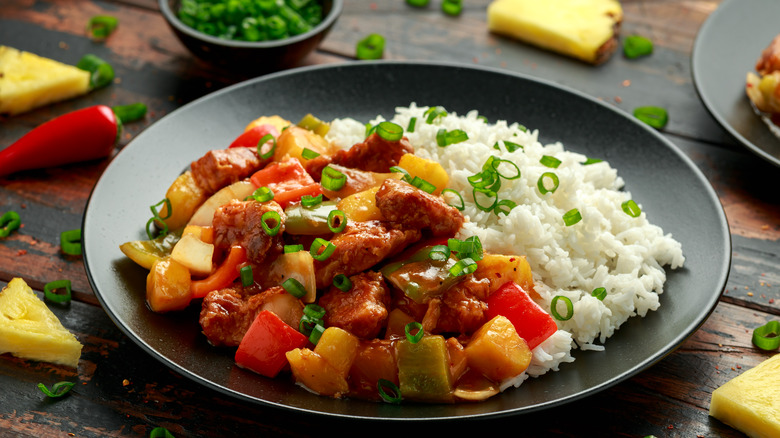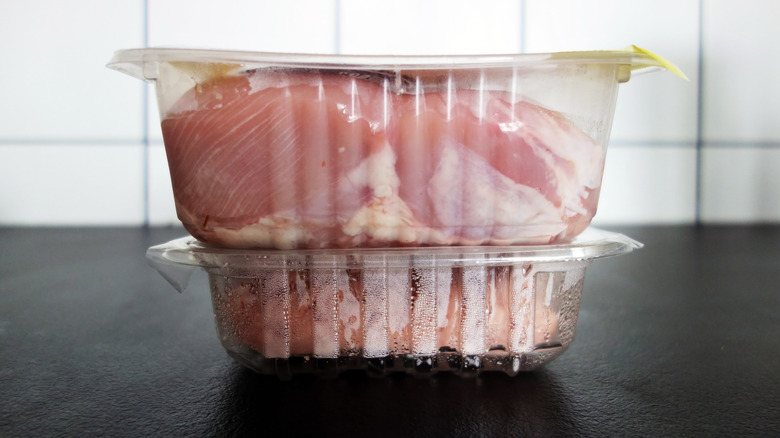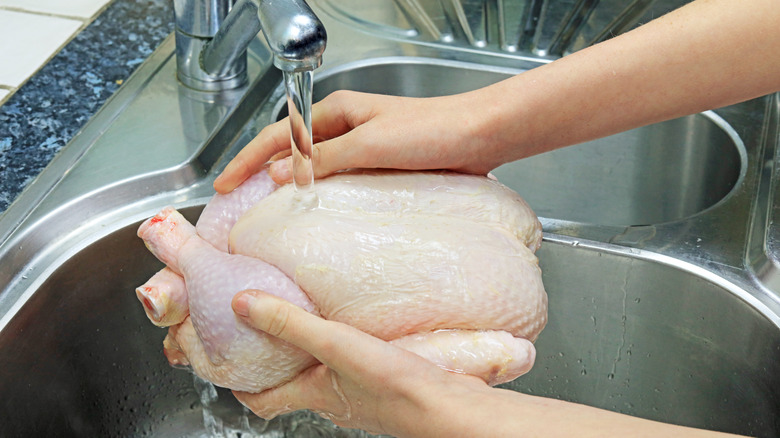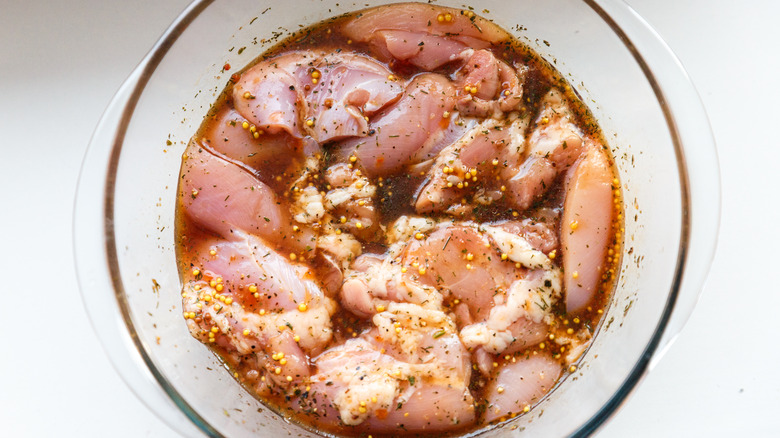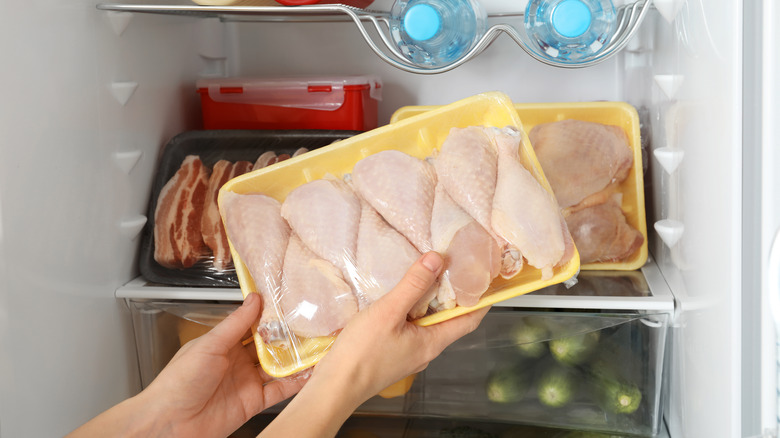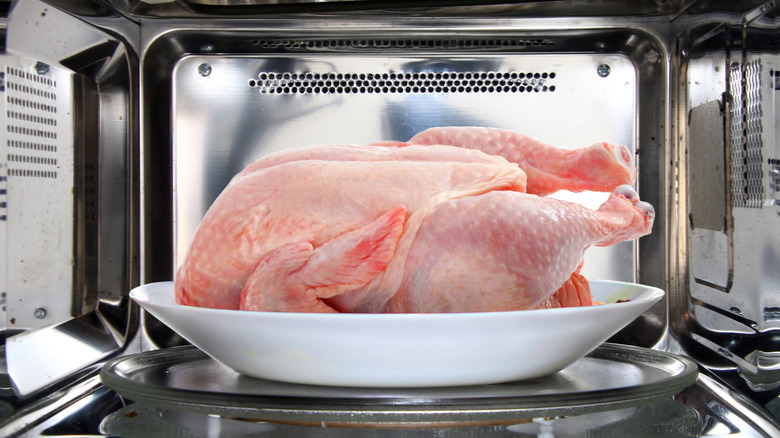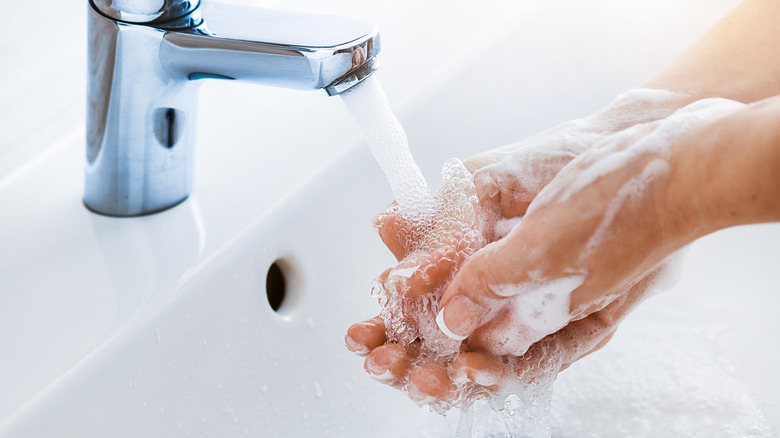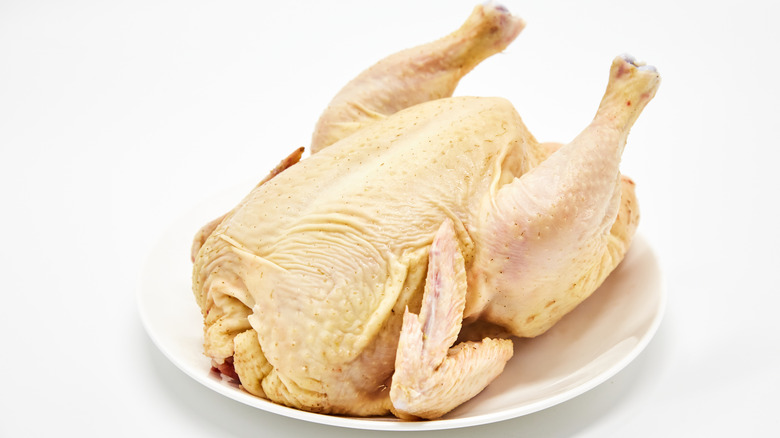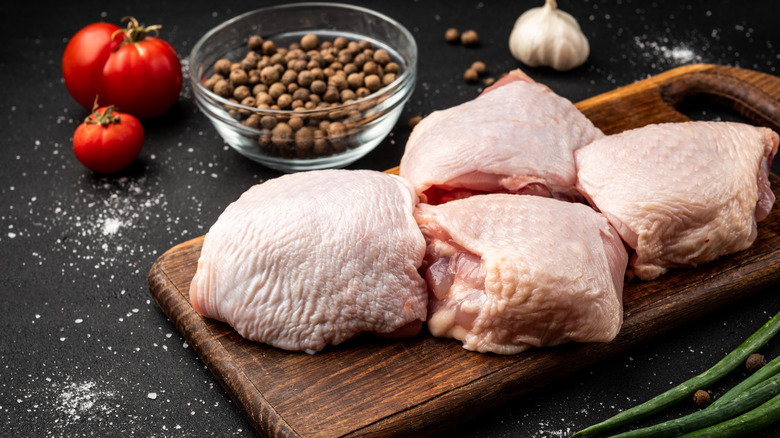Mistakes Everyone Makes When Thawing Chicken
Whether you're dreaming of a steaming wok full of pineapple chicken chow mein or salivating over the thought of a white plate covered with savory, crispy baked chicken Parmesan, one thing remains the same: you'll need chicken for your recipe. Budget-minded shoppers often pick up packages of chicken at the grocery store when they're on sale and stock up. It makes it easier when meal prepping for the week and planning out recipes when you know that you already have chicken in the freezer. All you need to do is pull a package out and defrost the poultry. But do you know the proper way to take the chill out of the chicken and get it ready to be cooked, grilled, or baked?
There are numerous missteps people can make when defrosting their chicken. Many folks are too impatient and don't want to allow it to properly defrost in the refrigerator, so they plop the package of chicken on the counter to warm up to room temperature. Others opt to defrost their chicken on the top shelf in the fridge, which exposes the rest of the fridge and the food inside to a dose of potentially harmful bacteria courtesy of that defrosting package of poultry.
Some of the methods cooks use to defrost frozen chicken range from slightly crazy to downright dangerous. No one wants a side of food poisoning with their poultry, so be careful not to make these same mistakes when defrosting frozen chicken for your next mealtime.
Leaving frozen chicken out on the counter all day
As tempting as it may be, do not plop your package of poultry on the kitchen counter to sit out all day, with the intention to thaw it using only the warmth of the room's ambient temperature. It's quite a common mistake, meaning you may have seen it done yourself in other kitchens. But doing so can cause dangerous bacteria to grow on the meat, ruining dinner time. Instead, the safest place to thaw out that bird is in the refrigerator, using an ice-cold water bath, or even in the microwave.
Leaving frozen poultry out on the counter to thaw enters it into what the Food Safety and Inspection Service (FSIS) of the USDA calls the "danger zone." That would be the temperature range between 40 and 140 degrees Fahrenheit. At these temperatures, the bacteria that cause food poisoning and similar sicknesses (such as Staphylococcus aureus, Salmonella Enteritidis, E. coli, and Campylobacter) are known to multiply rapidly and contaminate the poultry. No one wants chicken with a side of a stomachache for dinner — or, even worse, a full-blown case of potentially dangerous food-borne illness — so be sure to skip this method entirely. All told, there are much safer and more effective ways to get your frozen chicken ready for the dinner table.
Using hot water
It may sound supremely tempting to speed things up with the hot water tap, but do not pop the package of poultry into a container of hot water or run it under the same. That's because the high temperatures used to defrost chicken this way actually serve as a breeding ground for harmful bacteria and can often lead to a lack of uniform defrosting. This means that portions of the chicken are then plunged into that temperature danger zone that can breed harmful bacteria (via USDA).
So what should you do with a frozen chicken, then? If you want to defrost your chicken using water, you actually need ice cold water to safely speed up the defrosting process. Just be sure not to place the frozen meat under running water, as that can cause bacteria to spray inside your sink, across your countertops, and everyone in close proximity to the chicken, according to Healthline.
Plus, the cold soak method is pretty simple. The USDA recommends that you either leave the chicken in its original airtight packaging or slip it into a leakproof plastic bag, which helps contain the spread of bacteria. Then, submerge the chicken in the packaging or the bag under cold tap water. You'll need to swap out the water every 30 minutes or so until the chicken is fully thawed, which can take up to 3 hours for a 3 to 4 pound chicken or even less for smaller packages.
Defrosting chicken near other food
Another common mistake people make when defrosting their chicken is to allow it to defrost next to veggies or other ingredients to be used in a recipe, according to Food Insight. For example, when defrosting meat for kabobs, be sure not to allow the chunks of chicken to commingle with the veggies or fruit that you plan to slide onto the kabob stick. Doing so could spread possible contaminants — and we're pretty serious about keeping that bacteria off those other ingredients here.
Also, as ABC News cautions, never reuse the marinade that has already been in contact with defrosting chicken or any other kind of defrosting meat, for that matter. Whether you marinated the meat in a plastic ziptop bag or in a shallow baking dish, skip saving the marinade for use with the veggies or other ingredients. That's because any harmful bacteria hanging out on the surface of the raw meat can be swimming around in the marinade. If you reuse it, those germs will be easily transferred to whatever else comes into contact with the same liquid. And if you happen to be basting raw poultry with that marinade, stop partially through the cooking process to give the heat time to kill off bacteria.
Defrosting chicken on the fridge's top shelf
Unless you want your refrigerator to resemble a murder scene from a horror movie, do not place the package of poultry on the top shelf of your fridge to defrost. As meat defrosts, it produces liquid that often resembles reddish-pinkish blood. It's not, though, if that helps. It's actually what scientists call "purge," according to the American Meat Science Association. So, this situation is thankfully not the same as the scary movie of the same title. Instead, it's a combination of water and meat proteins that drain out of the meat as it loses its frozen form and softens while defrosting.
According to the American Meat Science Association, meat actually consists of 75 percent water, which contributes to its juiciness when served up fresh. But as meat defrosts, is handled, cut, or cooked, the proteins lose their ability to hang onto the water. As a result, it releases the liquid and those proteins, known as myoglobin, along with that red hue.
As you may have already guessed, that liquid can still carry bacteria. Even if that's not blood leaking from the top shelf onto everything below, it's still pretty gross and potentially dangerous. So just play it safe and set your meat on a plate or in a shallow baking dish to catch the liquid. And, above all, store it on the lowest shelf possible so it doesn't contaminate the rest of the food in the fridge and make a giant mess.
Defrosting chicken in the microwave, then waiting to cook
Microwaving frozen chicken in an attempt to defrost is, at least if done correctly, a decent way to get the thawing process started. However, it's pretty unwise to defrost frozen chicken in the microwave, then let it hang out for a prolonged period of time. You need to cook the chicken immediately after thawing it in the microwave because this process essentially jump-starts the cooking process and sends the meat into the danger zone temperatures that can allow bacteria to proliferate. You can't let it sit out because any bacteria that are already present on the surface of the chicken will not have been killed yet. Allowing it to hang around before cooking up that chicken can just give that bacteria more of a chance to proliferate and make people sick.
According to the Bearded Butcher Seasoning Company, microwaves heat moisture and create steam, but it's actually the moisture from the chicken escaping. To properly defrost your chicken in the microwave, according to the BBC, place the chicken on a microwavable plate, just one or two pieces at a time. Use the defrost setting for just one minute at a time.
Touching defrosting meat
If there's anything we've learned during the global covid-19 pandemic, it's how important hand washing really is to maintain the health and safety of yourself and the people around you. That's doubly true in a kitchen, regardless of the public health situation going on outside your home. It's especially important to wash hands before and after touching raw meat — again, because of all the bacteria that could be lurking unseen on the surface of said meat. Would you really want to spread that to other surfaces in your kitchen, your own skin, or other people?
Even if you can avoid touching that defrosting meat with your bare hands, be sure to wash your hands just the same. Yes, that's even if you only touched the exterior of the packaging. There's still a plethora of bacteria looming on the meat's surface and you want to be sure. Wash your hands with soap and warm water for 20 seconds both before and after handling food. The USDA reminds cooks to wash their hands and cooking surfaces often. Also, remember not to cross-contaminate food, cook meat to proper temperatures, and refrigerate leftovers promptly.
While you're at it, don't forget that germs can be transferred from raw meat to cutting boards, per Food Insight. While washing your hands, give your cutting board a bath in hot soapy water, particularly if you need to use it again to cut other ingredients. Even better, designate a separate cutting board for meat only.
Refreezing thawed chicken
You might have had some frozen chicken thawing in the refrigerator all day long, but the kids come home from school and want nothing to do with homemade chicken and noodles served over yummy mashed potatoes. Or, it could be that those from-scratch chicken tenders just don't sound delicious anymore. Or maybe you had a long day at work or a tough day home and you just don't feel like cooking when that wonderfully relaxing couch is calling your name. In fact, a pizza delivered straight to your house sounds like the most appealing option of all after the day you've had. So, you may go ahead and call that take-out place, but you've still got to figure out what to do with that half-thawed chicken waiting in the fridge. Should you just pop it back into the freezer and let it wait its turn?
In short, no. While it's incredibly tempting to simply refreeze the thawed-out chicken, the overwhelming advice here is to not do it. Per Food Network, simply refreezing chicken changes the structure of its protein and allows extra water to come out. This means that the taste and texture of the refrozen, then re-thawed chicken simply won't be up to snuff, unless perhaps you're going to use it in a liquid application like a stock or soup. If you've stuck in the above situation, you may need to buck up and cook that chicken, then save the cooked parts for tomorrow's meal.
How to properly thaw chicken
Allowing your frozen poultry to defrost on the lowest level of the refrigerator is the safest method to get a frozen chicken ready to cook, according to the USDA. That's because this method drastically reduces the risk of the chicken entering the dreaded temperature danger zone that allows bacteria to grow. But it's also the slowest method, so you must plan ahead and allow for enough time for the chicken to fully and thoroughly defrost before you need to use it. Other factors come into play when determining how long to defrost your chicken, such as the temperature your fridge is set at and how thick the packaged meat is. Plan for up to a day or two for this process, says the USDA.
Otherwise, a safe guideline in most cases is to allow five hours per pound to fully defrost your bird, according to the BBC. But if you're down to the wire, the Bearded Butcher Seasoning Company says that it is possible to halfway defrost chicken in the microwave to save you some time. Then, go with a cold water method to finish the defrosting process, making sure that you take the defrosted chicken straight from the water to cooking in order to keep germs from multiplying.
Surprisingly enough, you may not need to defrost your chicken at all, at least according to some sources. Perdue says you don't have to defrost chicken, but can just multiply the recommended cooking time by 1.5.
